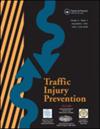High-risk powered two-wheelers scenarios generation for autonomous vehicle testing using WGAN
IF 1.6
3区 工程技术
Q3 PUBLIC, ENVIRONMENTAL & OCCUPATIONAL HEALTH
引用次数: 0
Abstract
Objective
Autonomous vehicles (AVs) have the potential to revolutionize the future of mobility by significantly improving traffic safety. This study presents a novel method for validating the safety performance of AVs in high-risk scenarios involving powered 2-wheelers (PTWs). By generating high-risk scenarios using in-depth crash data, this study is devoted to addressing the challenge of public road scenarios in testing, which often lack the necessary complexity and risk to effectively evaluate the capabilities of AVs in high-risk situations.
Method
Our approach employs a Wasserstein generative adversarial network (WGAN) to generate high-risk scenes, particularly focusing on PTW scenarios. By extracting 314 car-to-PTW crashes from the China In-depth Mobility Safety Study–Traffic Accident database, we simulate outcomes using PC-Crash software. The data are divided into scenes at 0.1-s intervals, with WGAN generating numerous high-risk scenes. By using a cumulative distribution function (CDF), we sampled and analyzed the vehicle’s dynamic information to generate complete scenarios applicable to the test. The validation process involves using the SVL Simulator and the Baidu Apollo joint simulation platform to evaluate the AV’s driving behavior and interactions with PTWs.
Results
This study evaluates model generation results by comparing distributions using Wasserstein distance as an indicator. The generator converges after approximately 200 epochs, with the iterator converging quickly. Subsequently, 10,000 new scenes are then generated. The distribution of several key parameters in the generated scenes can be found to approximate that of the original scenes. After sampling, the usability of generated scenarios is 64.76%. Virtual simulations confirm the effectiveness of the scenario generation method, with a generated scenario crash rate of 16.50% closely reflecting the original rate of 15.0%, showcasing the method’s capacity to produce realistic and hazardous scenarios.
Conclusions
The experimental results suggest that these scenarios exhibit a level of risk similar to the original crashes and are effective for testing AVs. Consequently, the generated scenarios enhance the diversity of the scenario library and accelerate the overall testing process of AVs.
利用 WGAN 生成用于自动驾驶汽车测试的高风险动力两轮车场景。
目的:自动驾驶汽车(AV)有可能通过显著改善交通安全彻底改变未来的交通状况。本研究提出了一种新方法,用于验证自动驾驶汽车在涉及动力两轮车(PTW)的高风险场景中的安全性能。通过使用深度碰撞数据生成高风险场景,本研究致力于解决测试中公共道路场景所面临的挑战,这些场景往往缺乏必要的复杂性和风险,无法有效评估自动驾驶汽车在高风险情况下的能力:我们的方法采用瓦瑟斯坦生成式对抗网络(WGAN)生成高风险场景,尤其侧重于公共交通场景。我们从《中国交通安全深度研究--交通事故数据库》中提取了 314 起汽车与 PTW 之间的碰撞事故,并使用 PC-Crash 软件对结果进行了模拟。数据以 0.1 秒的间隔被划分为多个场景,其中 WGAN 生成了大量高风险场景。通过使用累积分布函数(CDF),我们对车辆的动态信息进行了采样和分析,以生成适用于测试的完整场景。验证过程包括使用 SVL 模拟器和百度 Apollo 联合仿真平台评估 AV 的驾驶行为以及与 PTW 的交互:本研究以瓦瑟斯坦距离为指标,通过比较分布情况来评估模型生成结果。生成器在大约 200 个历时后收敛,迭代器也迅速收敛。随后,生成 10,000 个新场景。可以发现生成场景中几个关键参数的分布近似于原始场景。经过采样,生成场景的可用性为 64.76%。虚拟仿真证实了场景生成方法的有效性,生成场景的碰撞率为 16.50%,与原始场景的碰撞率 15.0% 非常接近,展示了该方法生成真实和危险场景的能力:实验结果表明,这些场景表现出与原始碰撞相似的风险水平,可有效测试自动驾驶汽车。因此,生成的场景增强了场景库的多样性,加快了自动驾驶汽车的整体测试进程。
本文章由计算机程序翻译,如有差异,请以英文原文为准。
求助全文
约1分钟内获得全文
求助全文
来源期刊

Traffic Injury Prevention
PUBLIC, ENVIRONMENTAL & OCCUPATIONAL HEALTH-
CiteScore
3.60
自引率
10.00%
发文量
137
审稿时长
3 months
期刊介绍:
The purpose of Traffic Injury Prevention is to bridge the disciplines of medicine, engineering, public health and traffic safety in order to foster the science of traffic injury prevention. The archival journal focuses on research, interventions and evaluations within the areas of traffic safety, crash causation, injury prevention and treatment.
General topics within the journal''s scope are driver behavior, road infrastructure, emerging crash avoidance technologies, crash and injury epidemiology, alcohol and drugs, impact injury biomechanics, vehicle crashworthiness, occupant restraints, pedestrian safety, evaluation of interventions, economic consequences and emergency and clinical care with specific application to traffic injury prevention. The journal includes full length papers, review articles, case studies, brief technical notes and commentaries.
 求助内容:
求助内容: 应助结果提醒方式:
应助结果提醒方式:


